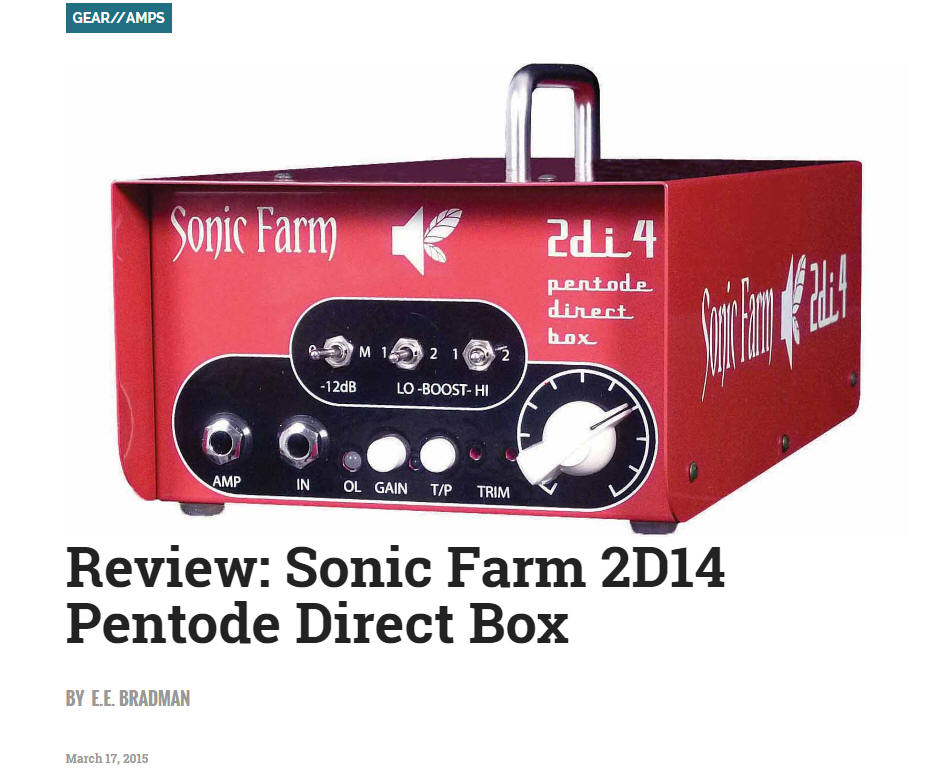 
IT’S A GREAT TIME TO BE
A BASS PLAYER with
a weakness for
bass-friendly preamps.
Never before have there
been so many cool and
portable options, both
tube and solid-state.
Most of us associate
tube preamps with
“warmth” and solidstate
preamps with “clarity,”
but there are many
definitions of “warmth”
and “clarity,” and many
shades in between. Sonic
Farm’s 2DI4 Pentode
Direct Box is a perfect
example
The 2DI4 is housed in a
strong steel box that’s
a hair under
five-and-a-half pounds,
and the switches and
buttons are solid; each
click feels decisive. On
the front of the unit
are an input jack, an
unbalanced ¼" amp
output, a green LED that
glows red when
overdriven, a gain
button, a power LED,
push-button access to
triode and pentode tube
settings, two small
holes that hide
tweakable low- and
high-frequency boost
levels (I left them at
the default, maximum
settings), and a
“chickenhead” trim knob,
which handles output. EQ
happens courtesy of a
trio of threeposition
switches: 0dB/–12dB/mute
selector, three-position
lo boost, and
three-position hi boost.
Around back are DI,
line, and xlr outputs, a
ground lift, the fuse,
voltage switching, and
the power switch.
PENTODE POWER
Using the di out into a
Digidesign Digi 003
board running Logic X, I
recorded a stock,
maple-neck 1958 Fender
Precision strung with
D’Addario nickels. The
2DI4 was absolutely
quiet, and in triode
mode, the ’58 P’s tone
as captured by the 2DI4
was detailed, clear, and
strong, with just a
touch of warmth. The
loud pop that occurred
when engaging and
disengaging the mute or
using the boost switches
after changing tube
settings was a bummer,
but I found the EQ
changes gentle, subtle,
and musical. The lo
boost, switched to the
left, added clear warmth
at 300Hz; to the right
was another bump at
500Hz. Similarly, the hi
boost switched to the
left added top end at
2kHz, and to the right,
at 4kHz. Putting either
switch in the center
left the tone
unaffected. Pushing in
the gain button
deactivated the hi and
lo boosts but hit the
single EF86 tube harder,
bumping up the output by
5dB in triode mode and
9dB in pentode mode. I
preferred using the
boosts for more specific
frequency tweaking,
turning up the trim knob
to adjust output level.
The 2DI4 sounds
perfectly fine in triode
mode, but pentode mode
brought out a whole
other beast. The 9dB
gain surge and
turbocharged,
harmonically rich
character were instantly
noticeable. Each
frequency boost was
pleasingly musical while
still maintaining the
character of my
instruments. Switching
back to triode mode gave
a mellower voice, with
less output but way more
headroom, and it was
closer, perhaps, to what
many folks think of as
“tube tone”—rounder,
with a softer, less
prominent attack.
When I used the amp out
jack, however, things
were a little different.
I plugged in an active
Atelier Z 5-string with
Dunlop Super Brights,
sending the signal from
the amp out to the power
section of an Aguilar DB
750 and driving two DB
112 1x12 cabs. The sound
was clear, but the
differences between EQ
points were
imperceptible, and the
trim knob was
ineffective.
STOUT
Using the line out jack
to Bergantino IP112 1x12
and HT-112-ER 1x12 cabs
did the trick, though.
In pentode mode, an
Elrick Gold-series
prototype 6-string
sounded meaty and alive,
and both lo boosts were
subtle but pleasing.
Instead of making the
tone fatter across the
spectrum, boosting the
2DI4’s lows highlighted
just the right low-mid
frequencies in
conjunction with the
Elrick’s onboard
Bartolini preamp.
Similarly, boosting the
highs imparted two types
of “air,” right in the
sweet spots; putting the
bass into passive mode
yielded similarly
pleasing results.
Overall, the 2DI4’s
voice leans toward
strong and stout instead
of fat and pillowy, but
there’s nothing glassy,
shrill, muddy, or mushy
about this preamp.
The 2DI4 strikes a
balance between
sophistication and
simplicity. The
tonesculpting options
are few but well chosen,
and the 2DI4 preamp in
pentode mode roars like
a lion. If you’re in the
market for a portable,
muscularly transparent
hybrid tube-pre/DI with
limited but supremely
musical options, you’ve
probably already heard
about the 2DI4. Go try
it!
SPECIFICATIONS
SONIC FARM
2DI4 Pentode Direct Box
Street $850
Pros Detailed
and transparent;
frequency boosts in the
sweet spots
Cons EQ
too subtle from amp
output; loud pops when
changing settings
Bottom Line A
hybrid tube-pre/DI that
boasts well-chosen EQ
options and a singular
balance of clarity and
warmth.
SPECS
Channels One
Tube EF86
Tube modes Triode
& pentode
Frequency response
10Hz–50kHz ±3dB
Maximum gain 54dB
at line output, 32dB at
DI (mic level) output
Harmonic distortion <2%
before clipping
Maximum line output level
30dBu
Minimum output load 60
Connectors xlr
DI and line output
(balanced only)
Instrument input ¼"
unbalanced, mono
Input impedance 2.2M
Amp output "
unbalanced, buffered
mono
Power consumption 15W
Operating voltage 110–120VAC
or 220–240VAC,
switchable
Transformer Cinemag
Made in Canada
Contact sonicfarm.com
|